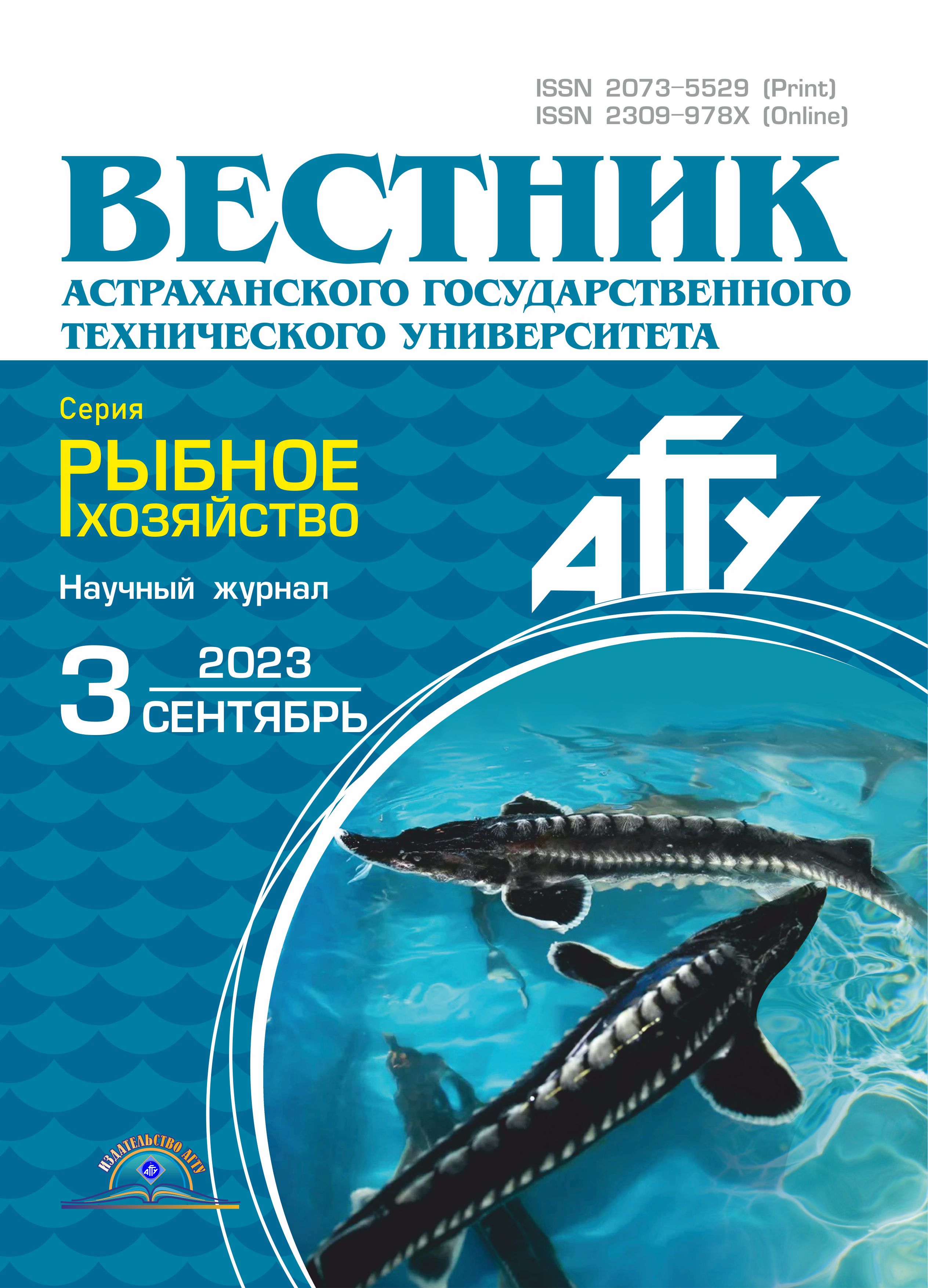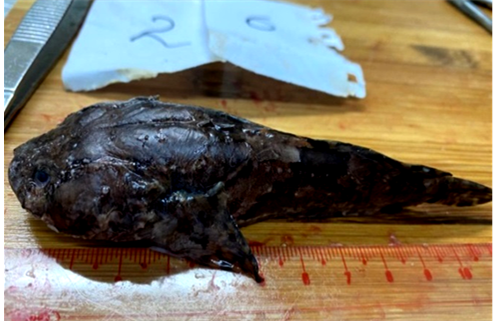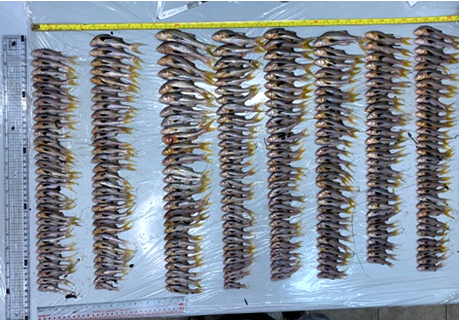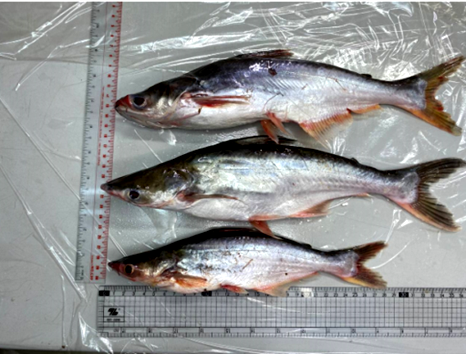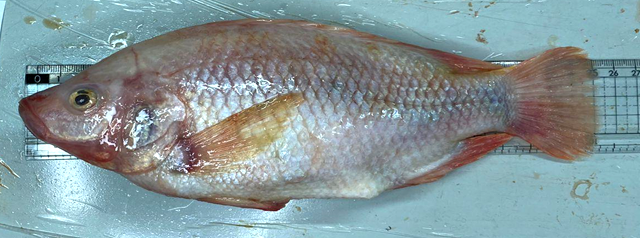Россия
Россия
Россия
Россия
Россия
Россия
Россия
Исследования проводились на базе Южного отделения Совместного Российско-Вьетнамского Тро-пического научно-исследовательского и технологического центра (г. Хошимин). Были получены предварительные данные о видовом составе ихтиофауны бассейна р. Меконг на территории Южного Вьетнама. Ихтиофауна исследованных рек была представлена не менее чем 20 видами. Наибольшее видовое разнообразие рыб отмечено в р. Хам Луонг (провинция Бенче) – 7 видов, в р. Меконг (провинция Донгтхап) – 6 видов рыб, а в реках Митхо (провинция Тьензянг) и Бассак (город Кантхо) – по 5 видов рыб соответственно. В ходе изучения морфометрических показателей рыб из рек различных провинций Южного Вьетнама были сделаны следующие выводы: наиболее крупные морфометрические промеры имели карповые. Средняя длина тела представителей вида Barbonymus gonionotus из р. Меконг (провинция Донгтхап) варьировала от 17 до 23 см и была на уровне 19,4 ± 2,53 см, масса тела при этом – от 92 до 200 г (128,0 ± 43,75 г). Средние коэффициенты упитанности по Фультону и Кларк составили 3,52 ± 0,6 и 2,94 ± 0,23 соответственно. В свою очередь, показатели длины тела этого вида рыб в р. Бассак (г. Кантхо) были на 37,88 % больше и составляли 26,75 ± 3,18 см, минимальные и максимальные значения – 24,5 и 29 см соответственно. При этом показатель массы тела был в 2 раза больше и составлял 301,0 ± 83,44 г, средние коэффициенты упитанности по Фультону и Кларк были на уровне 3,58 ± 0,06 и 2,91 ± 0,23.
виды рыб, морфометрические показатели, рост, р. Меконг, объекты аквакультуры, ихтиофауна
Introduction
Vietnam, according to FAO data for 2020, rounds out the top seven countries that account for 50% of the global volume of industrial fishing products (FAO, 2020). The average annual consumption of shrimp and fish per capita in the country makes 16.8 kg [1].
The Mekong River is one of the most extensive natural reservoirs in Vietnam [2]. About 850 species of fish live here [3].
At the same time, with industrial fishing, the country has favorable territorial conditions for the development of fisheries. Therefore, aquaculture is also one of the key industries in the Republic and it is legally enshrined in the strategy of socio-economic development of Vietnam. One of the directions of the aquaculture sector is commercial cage fish farming, which is actively developing, carrying out the cultivation of fish in cages installed in natural reservoirs, including the Mekong River. The Mekong River and its delta have an advantageous natural location for the development of aquaculture [4].
Aquaculture in Vietnam is based on the principles of biodiversity conservation and prevention of negative impacts of environmental factors [4]. However, the cultivation of fish in conditions of intensive industrial technologies is associated with various stress factors that directly affect the physiological state of the farmed fish and environmental pollution [5].
Industrial cultivation of fish and its industrial fishing from natural reservoirs of Vietnam is a very popular economic sector for the Republic.
In this regard, studies on monitoring morphometric indicators of individual representatives of the ichthyofauna of wild populations and aquaculture objects in the natural reservoirs of South Vietnam are necessary and in demand. Morphometric indicators are used to assess the adaptive response of organisms [6–8]. In accordance with the concept of S. S. Schwartz, any change in the living conditions of animals is directly or indirectly associated with a change in the energy balance, which inevitably leads to corresponding morphofunctional shifts (an increase in the relative size of internal organs, etc.).
Our preliminary work was devoted to the study of the main species of ichthyofauna of the wild population and aquaculture facilities of South Vietnam in order to assess the size and weight characteristics and fatness of fish.
Material and methods of research
Research objects. The objects of research were fish of different species groups. The first group included 54 specimens of fish living in the Mekong River (Fig. 1) and its tributaries Ham Luong, Mitho, Bassac: Plotosus canius, Oxyeleotris marmorata, Brachirus panoides, Channa stiata, Datnioides polota, Pangasius bocourti, Arius maculatus, Polynemus melanochir, Barbonymus gonionotus, Henicorhynchus lobatus, Parambassis wolffii, Synaptura commersonnii, Nibea soldado, Oxyeleotris urophthalmus, Polynemus aqilonaris, Pangasius bocourti, Anabas testudineus, Ctenopharyngodon idella, Barbonymus altus (Fig. 2).
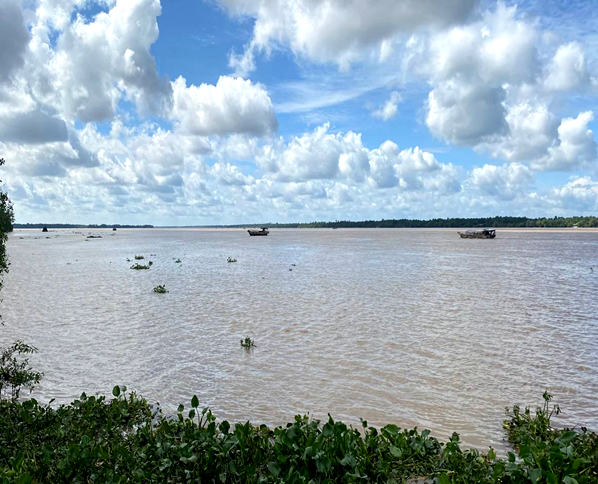
Fig. 1. Mekong River (South Vietnam)
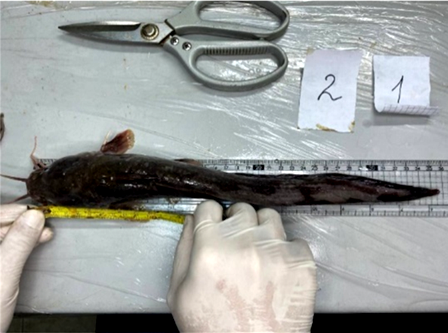
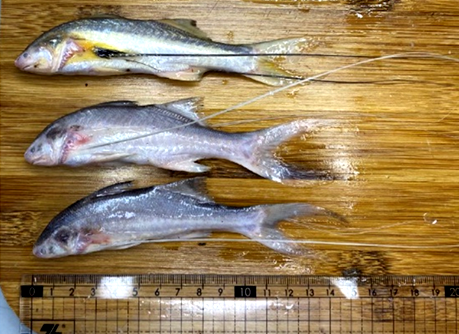
а b
|
|
|
|
c d
e |
|
Fig. 2. Species diversity of fish caught from the rivers of the Mekong Basin:
а – Plotosus canius; b – Polynemus melanochir;
c – Oxyeleotris marmorata; d – Polynemus aquilonaris; e – Pangasius bocourti
In the second group, aquaculture fish grown in the cages of the Mekong River was presented. To conduct these studies, fish were purchased at the Binh Dien wholesale market – 22 specimens of fish belonging, according to [9], to 3 families (Latidae – 10, Anabantidae – 9, Cichlidae – 3) (Fig. 3).
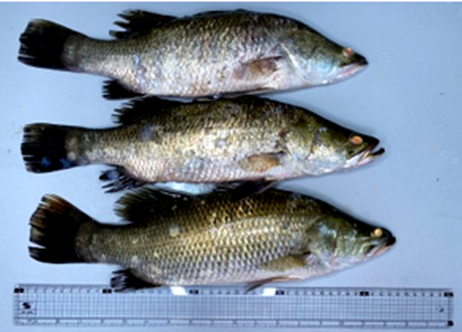
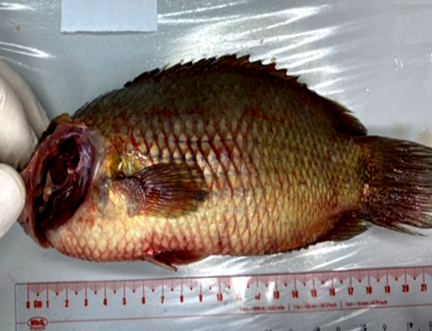
а b
|
c
|
Fig. 3. Species diversity of fish purchased from Binh Dien wholesale market:
а – Latidae, Lates calcarifer (Bloch, 1790); b – Anabantidae, Anabas testudineus (Bloch, 1792);
c – Cichlidae, Oreochromis niloticus (Linnaeus, 1758)
The research was conducted under the Southern Branch of the Joint Russian-Vietnamese Tropical Research and Technology Center (Ho Chi Minh City). Fish species were classified according to the determinant [9, 10]. When changing morphometric indicators (see Fig. 3), attention was paid to the following criteria: fish weight, total body length, body length to the end of the scaly cover, head length, maximum body height, body circumference.
Determination of the size and weight of fish. Fish sizes were set in accordance with fishing regulations and current standards. Morphometric parameters were determined by measuring various structures of the fish body [11].
The length of the entire fish was measured in a straight line from the beginning (top) of the snout to the end of the longest blade of the caudal fin with the horizontal position of the fish (L), as well as to the end of the scaly cover at the base of the middle rays of the caudal fin (l3).
Determination of fatness. Fatness is characterized by the ratio of body weight and fat content in it to the length of the body in a cube or body weight to its volume. Thus, the fatness coefficient characterizing the quality of farmed fish was determined by T. Fulton
![]() ,
,
and E. Clark [12]
![]() ,
,
where Q is the fatness coefficient; l is the length of the fish to the end of the scaly cover; W is the mass of the fish; w is the mass of the fish without internal organs.
Statistical analysis. Statistical processing was carried out with the calculation of the average value, standard deviation, average error [13].
Results and discussion Morphometric indicators and the level of fatness of the studied fish species. Data on morphometric indicators of fish are presented in Table 1.
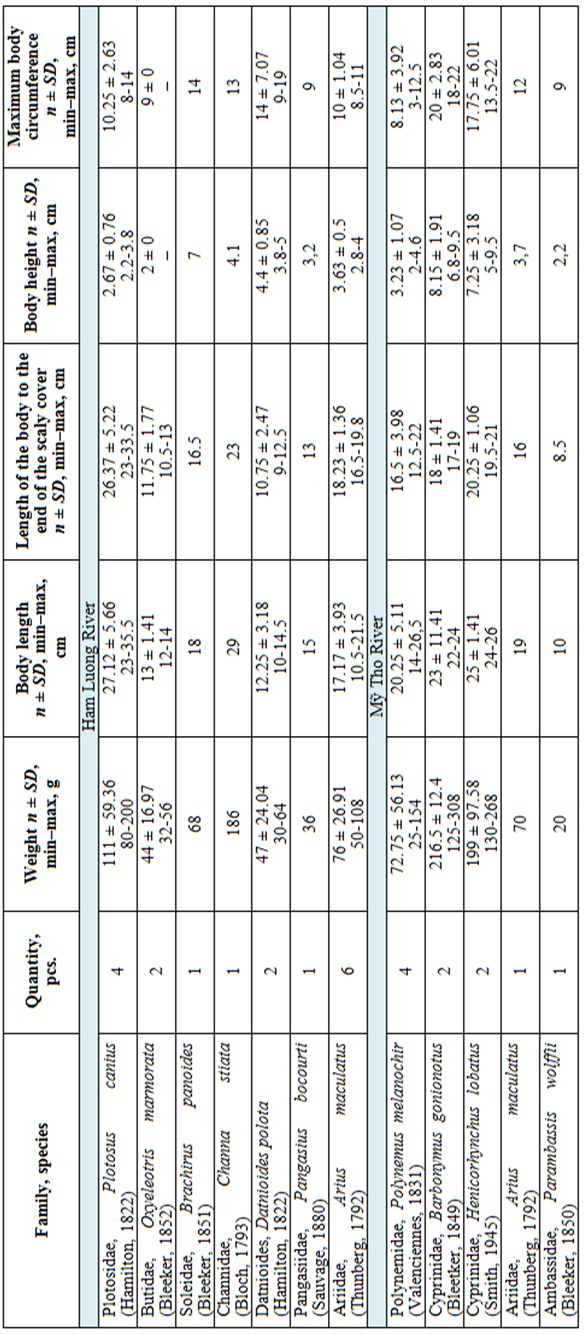
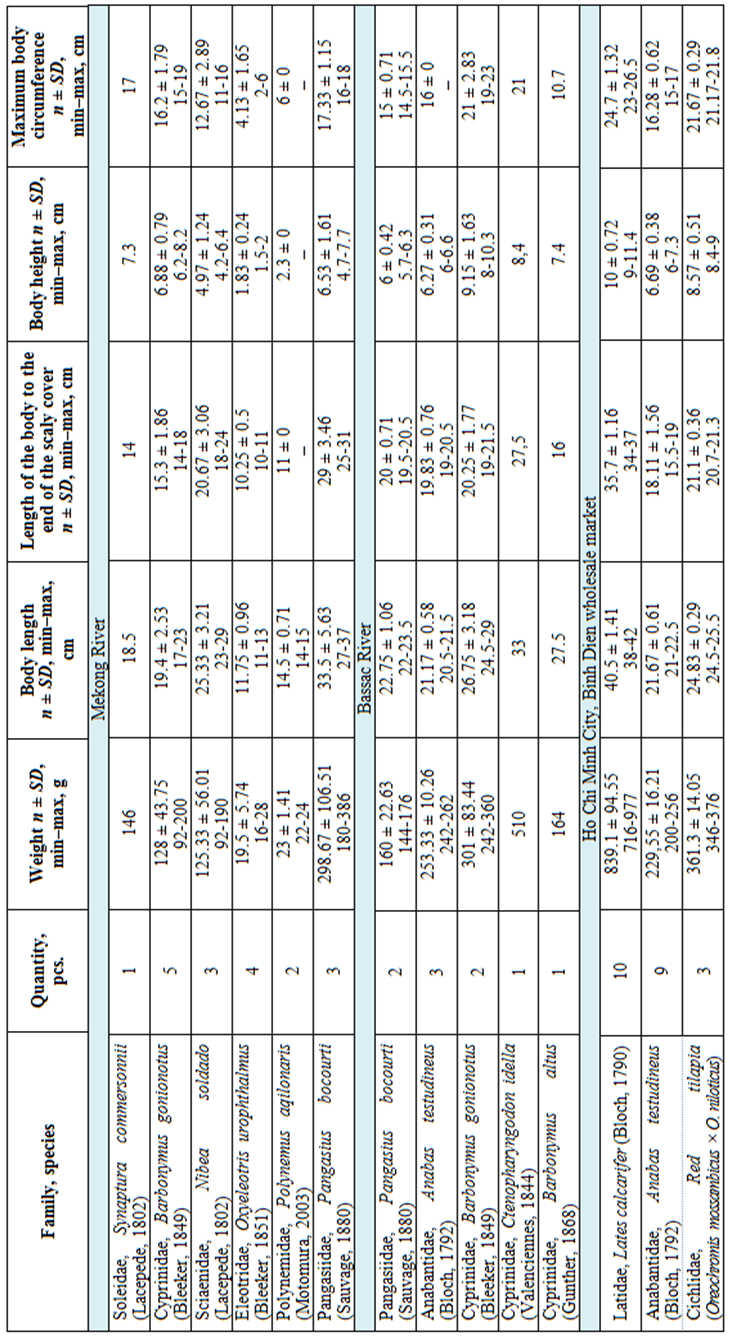
When studying the morphometric parameters of fish purchased at the Binh Dien wholesale market, it was noted that the Lates calcarifer species reached from 38 to 42 cm in length (average length 40.5 ± 1.41 cm) with a weight from 716 to 977 g (average weight 839.1 ± 94.55 g). The most common specimens were 42 cm long.
In turn, the Fulton and Clark fatness coefficient was 1.84 ± 0.17 and 1.68 ± 0.15 (Table. 2), respectively, which corresponds to the fatness of the studied fish in the autumn period (September).
Table 2
Fatness coefficients of the studied fish, according to Fulton and Clark
|
Family, species |
Number |
Fatness coefficient with organs |
Fatness coefficient without organs |
|
Ham Luong River |
|||
|
Plotosidae, Plotosus canius (Hamilton, 1822) |
4 |
0.59 ± 0.14 |
0.56 ± 0.15 |
|
Butidae, Oxyeleotris marmorata (Bleeker, 1852) |
2 |
2.66 ± 0.15 |
2.30 ± 0.17 |
|
Soleidae, Brachirus panoides (Bleeker, 1851) |
1 |
1.51 |
1.41 |
|
Channidae, Channa stiata (Bloch, 1793) |
1 |
1.53 |
1.45 |
|
Datnioides, Datnioides polota (Hamilton, 1822) |
2 |
3.7 ± 0.59 |
3.29 ± 0.59 |
|
Pangasiidae, Pangasius bocourti (Sauvage, 1880) |
1 |
1.64 |
1.35 |
|
Ariidae, Arius maculatus (Thunberg, 1792) |
6 |
1.33 ± 0.11 |
1.25 ± 0.13 |
|
Mỹ Tho River |
|||
|
Polynemus melanochir (Valenciennes, 1831) |
4 |
1.40 ± 0.08 |
1.22 ± 0.14 |
|
Cyprinidae, Henicorhynchus lobatus (Smith, 1945) |
2 |
2.32 ± 0.81 |
2.18 ± 0.74 |
|
Cyprinidae, Barbonymus gonionotus (Bleetker, 1849) |
2 |
3.52 ± 1.38 |
2.94 ± 0.76 |
|
Ariidae, Arius maculatus (Thunberg, 1792) |
1 |
1.71 |
1.61 |
|
Ambassidae, Parambassis wolffii (Bleeker, 1850) |
1 |
3.26 |
2.93 |
|
Mekong River |
|||
|
Soleidae, Synaptura commersonnii (Lacepede, 1802) |
1 |
5.32 |
5.28 |
|
Cyprinidae, Barbonymus gonionotus (Bleeker, 1849) |
5 |
3.52 ± 0.6 |
2.94 ± 0.23 |
|
Sciaenidae, Nibea soldado (Lacepede, 1802) |
3 |
1.38 ± 0.23 |
0.93 ± 0.75 |
|
Eleotridae, Oxyeleotris urophthalmus (Beeker, 1851) |
4 |
1.78 ± 0.24 |
1.59 ± 0.26 |
|
Polynemidae, Polynemus aqilonaris (Motomura, 2003) |
2 |
1.73 ± 0.11 |
1.58 ± 0.11 |
|
Pangasiidae, Pangasius bocourti (Sauvage, 1880) |
3 |
1.19 ± 0.10 |
1.01 ± 0.01 |
|
Song Hau River |
|||
|
Pangasiidae, Pangasius bocourti (Sauvage, 1880) |
2 |
1.99 ± 0.07 |
1.8 ± 0.04 |
|
Anabantidae, Anabas testudineus (Bloch, 1792) |
3 |
3.26 ± 0.25 |
2.97 ± 0.31 |
|
Cyprinidae, Barbonymus gonionotus (Bleeker, 1849) |
2 |
3.58 ± 0.06 |
2.91 ± 0.23 |
|
Cyprinidae, Ctenopharyngodon idella (Valenciennes, 1844) |
1 |
2.45 |
2.18 |
|
Cyprinidae, Barbonymus altus (Gunther, 1868) |
1 |
4.00 |
3.78 |
|
Binh Dien wholesale market |
|||
|
Latidae, Lates calcarifer (Bloch, 1790) |
10 |
1.84 ± 0.17 |
1.68 ± 0.15 |
|
Anabantidae, Anabas testudineus (Bloch, 1792) |
9 |
4.05 ± 1.27 |
3.63 ± 1.11 |
|
Cichlidae, Red tilapia (Oreochromis mossambicus × O. ni- |
3 |
3.85 ± 0.06 |
3.69 ± 0.03 |
The second fish species in size was represented by Red tilapia (Oreochromis mossambicus × O. niloticus), grown in aquaculture conditions. In this sample, tilapia reached sizes from 24.5 to 25.5 cm with an average length of 24.83 ± 0.29 cm. The weight of individuals ranged from 346 to 376 g, on average 361.3 ± 14.05 g. However, according to literature data, the body length of tilapia in nature can reach up to 35-39 cm with a weight of up to 1.1 kg [14]. The results of our research indicated that individuals raised in aquaculture with a sufficient amount of feed and nutrients can reach large sizes. The average fatness coefficients for Fulton and Clark are higher – 3.85 ± 0.06 and 3.69 ± 0.03, respectively.
The third species in terms of the size of individuals in this sample is Anabas testudineus. Representatives of this species had a body length from 21 to 22.5 cm (21.67 ± 0.61 cm), a mass from 200 to 256 g (on average 229.55 ± 16.21 g). These indicators did not differ from the literature data for previous years, where anabas in control catches was represented by individuals with a body length from 12 to 25 cm [15]. The average fatness coefficients of anabas were 4.05 ± 1.27 for Fulton, 3.63 ± 1.11 for Clark.
As for the representatives of Anabas testudineus species caught from the Song Hau River (Can Tho Сity), they had a body length from 20.5 to 21.5 cm (21.17 ± 0.58 cm), the weight of individuals varied from 242 to 262 g (average value 253.33 ± 10.26 g). However, the fatness coefficients of the wild anabas population were lower than those of market fish. Thus, the average fatness coefficients of anabas according to Fulton and Clark were equal to 3.26 ± 0.25 and 2.97 ± 0.31, respectively. Most likely, this is due to a less active diet or a lack of natural food in the area of catching this type of fish, and possibly with high turbidity of the water and the presence of a large number of suspensions in it.
The next representative of the fish studied was the species Plotosus cenius from the Ham Luong River. The length of this species varied from 23 to 35.5 cm (average length 27.12 ± 5.66 cm), while the weight ranged from 80 to 200 g (average 111.0 ± 59.36 g). The average fatness coefficients for Fulton and Clark were 0.59 ± 0.14 and 0.56 ± 0.15, respectively.
Two more specimens of Oxyeleotris marmorata were caught and studied from the same river, the length of which was 12 and 14 cm (13 ± 1.41 cm), and their weight, respectively, 32 and 56 g (44 ± 16.97 g). The Fulton and Clark fatness coefficients were 2.66 ± 0.15 and 2.30 ± 0.17.
Studying the morphometric parameters of representatives of Oxyeleotris urophthalmus caught from the Mekong River, their body length ranged from 11 to 13 cm (11.75 ± 0.96 cm), weight – from 16 to 28 g (19.5 ± 5.74 g). The average fatness coefficient according to Fulton and Clark is 1.78 ± 0.24 and 1.59 ± 0.26.
Two specimens of Datnioides polota in this sample had a body length of 10 and 14.5 cm (12.25 ± 3.18 cm), while the weight was 30 and 64 g (47.0 ± 24.04 g). The average fatness coefficient for Fulton and Clark was 3.7 ± 0.59 and 3.29 ± 0.59, respectively.
The species Arius maculatus was caught in an amount of 6 specimens. The average length of the fish reached 17.17 ± 3.93 cm. At the same time, a large variation in size and weight characteristics was observed: the minimum length values were 10.5 cm, and the maximum values were 21.5 cm; the weight of individuals varied from 50 to 108 g, where the average weight was
76.0 ± 26.91 g. In turn, the Fulton and Clark fatness coefficients, respectively, were 1.33 ± 0.11 and 1.25 ± 0.13.
Fish from the Mitho River, was represented by the following species: Polynemus melanochir, Barbonymus gonionotus, Henicorhynchus lobatus, Arius maculatus, Parambassis wolffii.
The body length of Polynemus melanochir ranged from 14 to 26.5 cm (20.25 ± 5.11 cm), while the weight of the fish ranged from 25 to 154 g (72.75 ± 56.13 g). The Fulton and Clark fatness coefficients are 1.40 ± 0.08 and 1.22 ± 0.14, respectively. The body length of the representatives of the species Polynemus aqilonaris was 14 and 15 cm (14.5 ± 0.71 cm), and the weight was
23.0 ± 1.41 g, the average fatness coefficient for Fulton was 1.73 ± 0.11, and for Clark – 1.58 ± 0.11.
Individuals of Barbonymus gonionotus from the Mitho River were somewhat smaller compared to the previous representatives from the Bassac River. Thus, the average body length was 23.0 ± 11.41 cm, and the weight was at the level of 216.5 ± 12.4 g, the average fatness coefficient according to Fulton and Clark is quite high – 3.52 ± 1.38 and 2.94 ± 0.76.
Henicorhynchus lobatus had a body length of 25.0 ± 1.41 cm, where the minimum and maximum values were 24 and 26 cm, while the body weight was 199.0 ± 97.58 g, with min and max values of 130 and 268 g. The fatness coefficient of Henicorhynchus lobatus according to Fulton was 2.32 ± 0.81; according to Clark, 2.18 ± 0.74.
Representatives of the species Arius maculatus and Parambassis wolffii, (Mitho River), Synaptura commersonnii (Mekong River), Brachirus panoides, Channa stiata and Pangasius bocourti (Ham Loung River), as well as cyprinid species Ctenopharyngodon idella and Barbonymus altus (Bassac River) were caught in a single instance. In this regard, their morphological data on average weight and body length were not taken into account. The Fulton and Clark fatness coefficients of Parambassis wolffii are 3.26 and 2.93, Arius maculatus – 1.71 and 1.61, respectively (Mitho River). However, in comparison with Arius maculatus caught from the Ham Luong River, the data obtained in this sample is slightly lower, which may indicate a smaller amount of food consumed or that the reservoir does not meet all the requirements for the maintenance of this type of fish.
Nibea soldado from the Mekong River had a body length of 23 and 29 cm. The average body length of representatives of this species was 25.33 ± 3.21 cm, and the body weight was 125.33 ± 56.01 g, while the minimum weight value was 92 g, and the maximum was 190 g. The fatness coefficient of Nibea soldado according to Fulton was 1.38 ± 0.23, according to Clark – 0.93 ± 0.75.
When studying the morphometric parameters of the Pangasius bocourti species, it was found that the individuals caught from the Mekong River had a body length of 33.5 ± 5.63 cm, which is 47.25% more than the individuals caught from the Bassac River. The body weight of these representatives was 298.67 ± 106.51 g, which was also 86.25% more than that of Pangasius bocourti in the Bassac River. However, the fatness coefficients of these fish from the Mekong River were 1.19 ± 0.10 (according to Fulton) and 1.01 ± 0.01 (according to Clark), and in individuals of the same species caught from the Bassac, were higher and equal to 1.99 ± 0.07 and 1.8 ± 0.04, respectively.
Studying the morphometric parameters of cyprinid fish from various provinces of Vietnam, it was found that the average body length of representatives of the species Barbonymus gonionotus from the Mekong River varied from 17 to 23 cm and was at the level of 19.4 ± 2.53 cm, body weight at the same time – from 92 to 200 g (128.0 ± 43.75 g). The average fatness coefficients for Fulton and Clark were 3.52 ± 0.6 and 2.94 ± 0.23, respectively.
In turn, the body length indicators of this fish species in the Bassac River were 26.75 ± 3.18 cm, while the min and max values were 24.5 and 29 cm, respectively, the body weight was 301.0 ± 83.44 g, the average fatness coefficients for Fulton and Clark were at the level of 3.58 ± 0.06 and 2.91 ± 0.23.
Conclusions
In September 2022, preliminary results were obtained on the species composition of the ichthyofauna of the Mekong River basin in South Vietnam. Out of the entire variety of ichthyofauna of the rivers of Vietnam, 26 species of fish (76 specimens) were studied. The greatest species diversity of fish was studied in the Ham Luong River – 7 species (26.92%), in the Mekong River – 6 species of fish (23.07%), and in the Mitho rivers and Bassac – 5 species of fish – i. e. 19.23%, respectively, also in the Binh Dien wholesale market – 3 types (11.55%).
The main representatives of the ichthyofauna of the Mekong River basin were classified as perch-like (32.89%), catfish-like (22.36%), carp-like (17.1%) and labyrinthine (17.1%).
The largest morphometric indicators were Lates calcarifer (Binh Dien wholesale market). Their body length was 40.5 ± 1.14 cm, with a mass of 839.1 ± 94.55 g.
Of the fish of the wild population, the largest soundings were carp-like. Thus, the average body length of representatives of the species Barbonymus gonionotus from the Mekong River varied from 17 to 23 cm and was at the level of 19.4 ± 2.53 cm, body weight at the same time – from 92 to 200 g (128.0 ± 43.75 g). However, there were also single large specimens, for example, 501 g – Ctenopharyngodon idella.
Of all the fish studied, the most well-fed were the labyrinthine fish Anabas testudineus. Thus, the fatness of aquaculture fish was 4.05 ± 1.27 for Fulton and 3.63 ± 1.11 for Clark, which is 19.5 and 18.2% more than Anabas testudineus from the Bassac River. Carp-like fish also had high Fulton and Clark fatness coefficients: 3.52 ± 0.6 and 2.94 ± 0.23, respectively. In turn, the indicators of fatness of this fish species in the Bassac River were at the level of 3.58 ± 0.06 and 2.91 ± 0.23, according to Fulton and Clark, respectively.
When studying the morphometric parameters of the Pangasius bocourti species from the Mekong River, it was found that, despite the higher indicators of their length and body weight, representatives from the Bassac River had fatness coefficients higher by 0.8 units per Fulton and 0.79 units for Clark. Which may indicate a more active diet and favorable living conditions.
Thus, our studies have shown that the morphometric indicators and fatness of the studied fish of the Mekong River basin of South Vietnam correspond to their species characteristics.
1. Minh-Ngoc Nguyen. Monthly average seafood con-sumption per capita Vietnam 2010-2020. URL: https://www.statista.com/statistics/1240216/vietnam-monthly-average-shrimp-and-fish-consumption-per-capita/ (дата обращения: 26.09.2022).
2. Михайлова М. В. Меконг. Большая российская энциклопедия. М., 2011. Т. 19. С. 619.
3. Козлов П. К. Русский путешественник в Центральной Азии. Избранные труды. К столетию со дня рождения (1863-1963). М.: Изд-во АН СССР, 1963. 535 с.
4. Григорьев В. И., Фам Тхи Д. Ч., Низамов Р. М., Григорьев И. В. Социалистическая Республика Вьет-нам на международных рынках продукции аквакуль-туры // Вестн. Казан. гос. аграр. ун-та. 2021. Т. 16. № 2 (62). С. 96-99. DOI:https://doi.org/10.12737/2073-0462-2021-96-99.
5. Golovacheva N. A., Ponomarev A. K., Nikiforov-Nikishin D. L., Brezhnev L. L. The experience of using a mineral chelate additive for growing juveniles of the Afri-can sharptooth catfish (Clarias gariepinus) in a recirculat-ing aquaculture system // Brazilian Journal of Biology. 2022. V. 84. e265119. https://doi.org/10.1590/1519-6984.265119.
6. Шварц С. С., Большаков В. Н., Пястолова О. А. Новые данные о различных приспособлениях живот-ных к изменению среды обитания // Зоологический журнал. 1964. Т. 13. № 4. C. 43-58.
7. Шварц С. С. Метод морфофизиологических индикаторов экологии животных // Зоологический жур-нал. 1958. Т. 37. № 4. С. 58-63.
8. Шварц С. С. Экологические закономерности эво-люции. М.: Наука, 1980. 278 с.
9. Tran D. D., Shibukawa K., Nguyen P. T., Ha H. P., Tran L. X., Mai H. V., Utsugi K. Mô tả định Loại Cá Đồng Bằng Sông Cửu Long, Việt Nam // Fishes of the Mekong Delta, Vietnam. Can Tho University Publishing House, Can Tho. 2013. 174 p.
10. Владимцева Т. М. Рыбоводство: метод. указания. Красноярск: Изд-во Краснояр. гос. аграр. ун-та, 2008. 37 с.
11. Правдин И. Ф. Руководство по изучению рыб. М.: Пищ. пром-сть, 1966. 96 с.
12. Kотляр О. А. Методы рыбохозяйственных исследований (ихтиология): учеб. пособие. URL: https://studfile.net/preview/9116249/ (дата обращения: 10.10.2022).
13. Лакин Г. Ф. Биометрия: учеб. пособие. М.: Высш. шк., 1990. 352 с.
14. Pullin R. S. V., Lowe-McConnell R. H. The biol-ogy and culture of tilapias // ICLARM Conf. Proc. 1982. 432 p.
15. Talwar P. K., Jhingran A. G. Inland fishes of India and adjacent countries. Rotterdam, 1991. V. 2. 1158 p.

